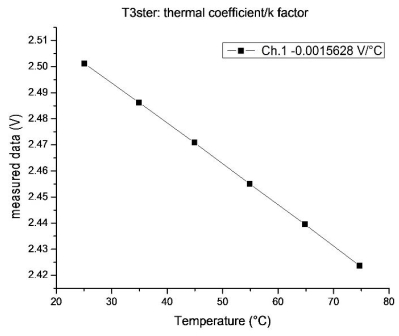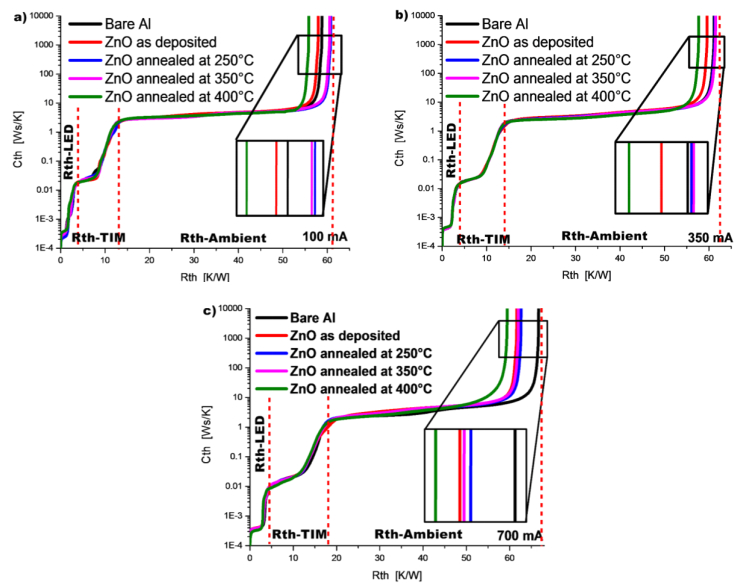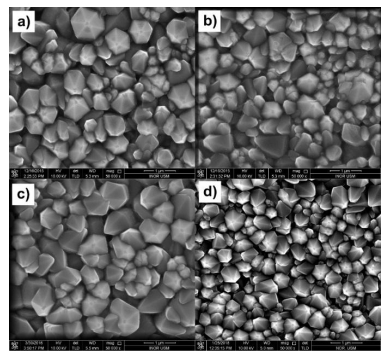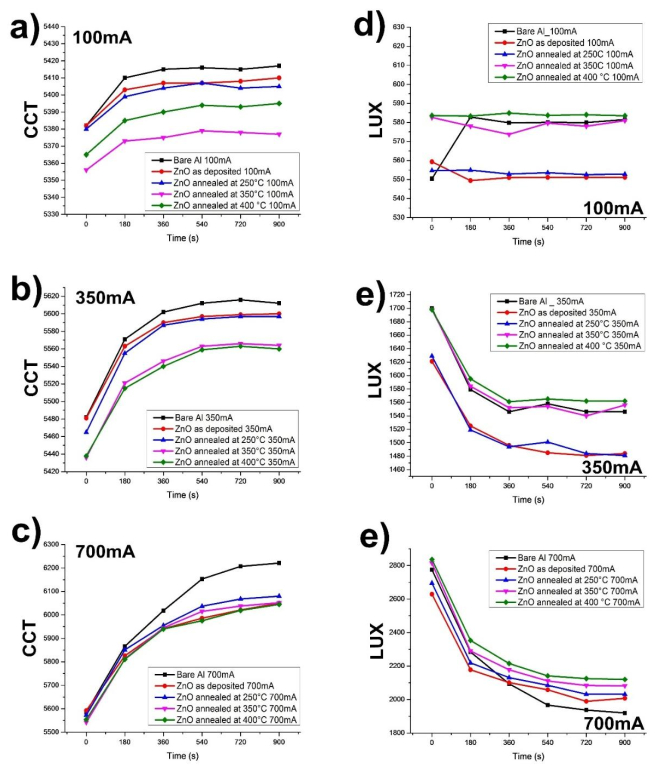In a solid-state lighting, the thermal performance of light emitting diode (LED) is one of the crucial aspects in determining the quality of the LED. To improve the thermal performance of LED, thermal interface material (TIM) was employed and proven to help the transfer of heat in solid state lighting. In this study, zinc oxide thin films were deposited on aluminum (Al) substrates using chemical vapor deposition method and the effect of annealing temperature was discussed. The thermal and optical performances of OSRAM golden dragon white LED attached on bare and ZnO thin film coated Al substrate were measured by Thermal Transient T3ster (T3ster) and Spectrometer respectively. Noticeable improvement in the reduction of junction temperature (ΔTj = 13.79 ℃) was observed for ZnO thin film annealed at 400 ℃ compared with the bare Al (without ZnO) boundary condition and hence improvement in optical output was achieved with the same boundary condition. Overall, rise in junction temperature, Tj of ZnO thin film demonstrated positive result in reducing the temperature of the LED package. The total thermal resistance (Rth-tot) was low for the sample coated with ZnO thin film compared with the bare Al substrate at high driving currents with the lowest reported value of 7.37 K/W for ZnO thin film annealed at 400 ℃. Correlated color temperature (CCT) and illuminance (LUX) value showed that the ZnO thin film sample displayed better performance than bare Al sample. From the result, it can be suggested that ZnO thin film would be an effective and suitable thermal interface material (TIM) for the solid-state lighting application.
1.
Introduction
Vaccinations protect vaccinees against multiple viral and bacterial infectious diseases. Post-vaccination, vaccinees experience no, mild adverse events, multiple adverse events, or serious adverse events. Adverse events associated with vaccinations are typically rare [1]. Some of these adverse events have been associated with allergic reactions to vaccine excipients including adjuvants [2] (e.g., polyethylene glycol [3]), or manufacturing contaminants (e.g., egg proteins [4]). Adverse events can occur immediately (e.g., anaphylaxis) or within hours or days post vaccination. Vaccine reactogenicity refers to the subset of adverse events that occur soon after vaccination and are physical manifestations of the inflammatory response to vaccination [1]. The intensity of these adverse event symptoms ranges from mild to severe. Many of these vaccinees are negatively impacted by these adverse event symptoms until they resolve. Adverse events temporally associated with vaccines are generally associated with immune responses, including humoral antibody responses, to one or more of the vaccine components.
To protect against SARS-CoV-2, multiple vaccines have been developed. These vaccines include traditional inactivated virus vaccines (CoronaVac, BBIBP-CorV, Covaxin), protein subunit vaccine (Novavax, ZF2001), replication-defective viral vector vaccines (AD5-nCoV, AZD1222, Sputnik V, Ad26.Cov2.S), and mRNA vaccines (mRNA-1273 and BNT162b2/Comirnaty) [5]. The SARS-CoV-2 spike vaccines (mRNA-1273, BNT162b2/Comirnaty, and Ad26.Cov2.S) are distributed in the United States. With broad distribution of these vaccines within the United States, associated adverse events are reported to the Vaccine Adverse Event Reporting System (VAERS) database [6]. The number of vaccine adverse reactions is higher for these SARS-CoV-2 spike vaccines than all other vaccines. Can data analysis of the VAERS vaccine adverse reactions responses provide etiology insights for these SARS-CoV-2 spike vaccines and other high reactogenicity vaccines?
Herein, the VAERS databases is examined for the most frequent adverse events across all vaccines. Overlaps were observed for the most frequently reported adverse events with symptoms associated with histamine intolerance. Herein, the hypothesis is advanced that the majority of vaccination reactogenicity adverse events are caused by elevated histamine levels from innate immune responses to vaccination temporarily exceeding the vaccinee's tolerance level; this includes the majority of the coronavirus disease 2019 (COVID-19) spike vaccine associated reactogenicity adverse events.
2.
Methods
The VAERS database [6] was data mined for vaccine adverse events data by vaccine type and onset post vaccination. The downloaded data includes all VAERS reports from 1990 until May 13, 2022. A Ruby program named vaers_tally.rb was developed to tally reported vaccine adverse events by vaccine [7]. The output from vaers_tally.rb consists of summaries by vaccine by dose, adverse event, and onset. A Ruby program named vaers_slice.rb was developed to tally selected reported vaccine adverse events by vaccine [7]. The vaers_slice.rb program takes as input a list of one or more symptoms to summarize and the yearly VAERS Symptoms, Vax, and Data files from 1990 to 2022. The output from vaers_slice.rb consists of five reports: summaries by vaccine, summaries by age of onset of symptoms, summaries by day of onset of symptoms, and two summaries of additional symptoms reported (selected symptoms and all other symptoms). The adverse events pyrexia (fever), headache, fatigue, chills, nausea, dizziness, pain, and pain in extremity were extracted. Microsoft Excel was used to create figures and to rank order vaccine symptoms for vaccines with the most reported adverse events.
3.
Results
The overlap between symptoms associated with histamine intolerance, anaphylaxis, and adverse events reported in VAERS are correlated in Table 1. The top 75 most commonly reported vaccine reactogenicity adverse events are shown for the seven highest reactogenicity vaccines in Tables 2 and 3. Figure 1 illustrates the day of onset for the most frequently reported adverse events for these seven vaccines. Extended reports by day of onset are illustrated for the pyrexia adverse event for these seven vaccines (Figure 2). Adverse events temporally associated with COVID-19 spike vaccines have more reports than adverse events associated with non-COVID-19 vaccines (Table 2).
4.
Discussion
A variety of adverse events are commonly associated with vaccination adverse events. Examples of common COVID-19 spike vaccine temporally associated adverse events include flushing or erythema (28%), dizziness or lightheadedness (26%), tingling (24%), throat tightness (22%), hives (21%), and wheezing or shortness of breath (21%) [14]; they note that 32 (20%) reported immediate and potentially allergic symptoms that were associated with the second COVID-19 vaccine dose were self-limited, mild, and/or resolved with antihistamines alone [14]. Many of the most commonly reported vaccine reactogenicity adverse events overlap with those of histamine intolerance syndrome (HIT) and anaphylaxis, see Table 1.
The top ranked ordered adverse events temporally associated with vaccinations are illustrated in Tables 2 and 3. Some adverse events are anticipated to be specific to injection sites without overlaps with oral vaccines. Two dominant patterns emerge in Figures 1 and 2 with respect to onset of adverse events in vaccinees. The first pattern is characterized by the highest frequency of reported adverse events post vaccinations having the highest numbers of reports immediately following vaccinations with rapid declines for subsequent days. Reporting bias likely contributes to lower frequencies of reports as the number of days post vaccination increases. For some vaccinees, a second pattern is noted for some symptoms consistent with the timing of humoral response to the vaccination days 7 to 10 days post vaccination, see Figure 2. The majority of reported vaccination associated adverse events are associated with immediate onsets for the first several days; this is illustrated for pyrexia with an average of 72% for days 0 & 1 and 84% for days 0 to 5 (Figure 2). For COVID-19 spike vaccines, 85% of the pyrexia adverse events are reported for days 0 & 1 and 94% for days 0 to 5 (Figure 2).
Herein, the observed overlap of vaccine associated adverse events across different vaccines suggests sharing of common cellular responses to vaccines; this enables exclusion of specific vaccine components as candidate causative entities. For initial vaccine exposures, the onset timing for the majority of the reported adverse events is insufficient for engagement of humoral immune responses. This immediate onset of symptoms is consistent with innate immune system response to vaccination. Granulocytes including mast cells are predicted to release inflammatory molecules, including histamine, as part of innate immune responses to vaccination. The majority of the top 75 ordered most frequently reported adverse events (Table 2) have significant overlaps with symptoms associated with histamine intolerance syndrome and anaphylaxis (64% for the top 25, 54% for the top 50, and 61% for the top 75 adverse events—Tables 1 and 2). Note that excluding adverse events associated with injection will increase these observed percentages. Histamine intolerance, also referred to as enteral histaminosis or sensitivity to dietary histamine, results from a disequilibrium of accumulated histamine and the capacity for histamine degradation [8],[15],[16].
5.
Hypothesis
Innate immune responses to vaccines include activation of mast cells to release histamine [17],[18]. Based on symptoms associated with elevated histamine levels, see Table 2, this article proposes the hypothesis that innate immune response to vaccination release histamine to elevated levels that are causative for the majority of vaccine reactogenicity adverse events. Multiple vaccine reactogenicity adverse events parallel those of histamine intolerance syndrome, see Table 1. A rapid increase in histamine from innate immune responses to vaccination may exceed the histamine tolerance level for many vaccinees with low to normal histamine tolerance. The number of vaccinees with adverse reactions is proposed to increase corresponding to the reactogenicity level of the vaccine. Coadministration of two or more vaccines may increase the likelihood of exceeding the vaccinees' normal histamine tolerance level. When the normal histamine tolerance level is not exceeded for some vaccinees, no adverse events are expected. Resolution of adverse event symptoms is predicted as histamine levels fall below the tolerance level. For most vaccinees, their vaccine adverse events resolve within a few days post vaccination. Elevated histamine levels are consistent with many of the adverse events temporally associated with vaccinations (Table 2). Histamine is involved in the contraction of smooth muscles, secretion of gastric acid in the stomach, vasodilation, modulation of heart rate and contractility [19], and body temperature [13]. Histamine can also sensitize nociceptive nerves associated with pain sensation [20]. Many histamine intolerance symptoms occur in combinations [11]. Some conditions can predispose individuals to vaccine associated adverse events. Histamine is metabolized by the diamine oxidase (DAO) enzyme. Genetic variants and medications can affect the histamine tolerance threshold for vaccinees. Patients with migraines have been identified with low serum DAO activity levels [21]; perhaps exhibiting histamine intolerance. Patients with allergies have higher frequencies of vaccine adverse events [22]. Other patients have experienced increased histamine sensitivity post vaccination [23].
6.
Testing the hypothesis
The model predicts elevated histamine levels peaking immediately prior to onset of vaccine adverse events; for most vaccinees, the start of symptoms onset is within one to two days following vaccination. This model can be evaluated by correlating histamine levels with onset and resolution of adverse event symptoms. It may be possible to confirm elevated histamine by elevated levels in urine or blood with the standard histamine laboratory test, its metabolite methylimidazole acetic acid in urine, plasma histamine, or serum tryptase (acute serum tryptase measurements >20 ng/mL) [24] in vaccinees with adverse response symptoms. An institutional review board (IRB) approved study could evaluate and compare histamine levels in volunteers (unvaccinated controls, vaccinees who experience no adverse reactions, and vaccinees with adverse reactions). Histamine baseline levels for volunteers could be measured prior to vaccination. Including the standard laboratory serum DAO test may provide additional supportive evidence.
Histamine levels are predicted by the model to peak prior to the onset of symptoms. Histamine levels are predicted to be returning towards baseline levels consistent with resolution of symptoms. One approach to evaluating this model would be to sample histamine levels prior to vaccination, at onset of symptoms, and at the resolution of symptoms. The model predicts that the histamine levels should be observed to be highest at the onset of symptoms; if observed, this would establish correlation. An alternative sampling approach collect samples at prior to vaccination and at defined time intervals (e.g., every 12 or 24 hours) for several days post vaccination. This second sampling strategy would include data from unvaccinated control volunteers and also vaccinated volunteers who develop no adverse event symptoms. The model predicts that histamine levels will be observed to increase in all vaccinees (with and without adverse event symptoms) but not in unvaccinated controls. Either of these sampling approaches should be able to establish or reject correlation of increased histamine levels corresponding with vaccine adverse event symptoms.
The model predicts that increased histamine levels is causative for the majority of vaccine reactogenicity adverse events. Hence, combination of prophylactic and therapeutic treatments may enable reductions in incidence rates and symptoms duration for some vaccinees. Treatments targeting granulocytes/mast cells, antihistamines, and supplemental DAO enzyme for histamine metabolism may provide some efficacy to vaccinees. IRB approved case-control studies could compare incidence rates, severity, and duration lengths of symptoms between control volunteers and volunteers treated prophylactically and therapeutically with these candidate treatments (overviewed in the next section). Positive efficacy results from these studies would further support the proposed model.
7.
Treatments
Treatments for reactogenicity adverse events include pain mitigation, antipyretics (prevent or reduce fever), etc. include local application of ice, paracetamol (acetaminophen), aspirin, or anti-inflammatories (e.g., ibuprofen) [1]. The model that most reactogenicity adverse events represent histamine intolerance symptoms suggests possible prophylactic and/or therapeutic treatments for evaluation in vaccinees. Antihistamine treatments exhibiting efficacy in treating COVID-19 patients are predicted to also target granulocytes and mast cells associated with vaccine responses. These candidate treatments for further evaluation include high dose famotidine [25]–[28], cetirizine [29],[30], and dexchlorpheniramine [29]. Oral treatment with diamine oxidase may also minimize, reduce severity, or eliminate vaccine reactogenicity adverse event symptoms in some vaccinees. Evaluation of these treatments and treatment combinations on vaccinees in case reports, case series, etc. can inform subsequent randomized controlled clinical trials for reducing vaccine reactogenicity adverse events. This model and candidate treatments should be applicable to all vaccines.
8.
Conclusions
The hypothesis that most vaccine reactogenicity adverse events are caused by temporal excess of histamine level is presented. The pattern of reactogenicity adverse events share overlaps between most or all vaccines including reports for COVID-19 spike vaccines. Evaluating histamine, histamine metabolite, and DAO serum levels in affected vaccinees can support or refute this model. The proposed etiology suggests possible prophylactic and therapeutic treatments for reducing vaccine reactogenicity symptoms, including antihistamines, mast cell stabilizers, and DAO enzyme supplements. Antihistamines are already occasionally used as therapeutic treatments for selected vaccine reactogenicity symptoms like rashes.









 DownLoad:
DownLoad:












